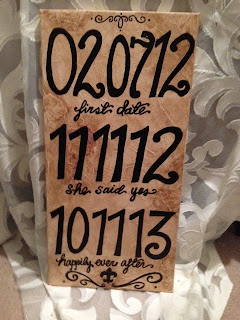Call me a romantic, but I just love everything about weddings! I especially love making wedding presents, and found this idea on Pinterest a while back. There is just something about a customized wedding gift that is so personal and really shows thought and intent on the givers part. While the technique and font came from me, I just loved the idea of telling a the couple's love story that features three dates- first date, the proposal date, and wedding date. This idea can be used for other things too- what about down the road making one with date's of your children's births, or even dates for big occasions like a job promotion, or a big travel trip?
Here's how I went about this. I first sketched my idea and practiced my font and layout on a piece of paper. I wanted the numbers to be roughly twice the space as the sentiment written below since the feature for me was telling the story in numbers.
Next, I went canvas shopping, and because I don't like to buy anything that isn't on sale, found a good deal of these guys in a 2-pack. I prefer the longer rectangular canvas, but go for whatever you prefer or will fit with your decor. These are 10" by 21" and I've used larger before depending on the space etc.

Materials used in total for this project:
-Scratch Paper and pencil
-Ruler
-Eraser
-Canvas of your choice
-Heavy acrylic white paint
-Small artist trowel
-Burnt Umber acrylic paint
-Super Sharpie with fine tip
-Medium artist brush
-Paper towels
-Acrylic painting spray sealer
I love the look of plaster, and wanted to add that texture to this canvas. To achieve that look, I first took acrylic white paint and the trowel and covered the entire surface of the canvas. I didn't want the paint very thick, but I wanted enough to take away the texture of the canvas. Don't worry about this being even and neat- the little peaks and imperfections in the trowling work is what gives the finished piece character!
I normally let this dry overnight. I then like to take some burnt umber or any brown acrylic paint you have around and mix with a little water to create a wash. Using the brush, I apply this to the surface of the canvas, then use a paper towel to gently wipe of excess. Only do a section at a time so you don't have a spot drying while you are working. This takes some time to do because you want to make sure you have a relatively even color, which might mean reapplying a little of the wash in areas again. Warning: avoid creating light spots by going over your paint again before it dries. I've found that if I try to make an area darker when the paint didn't have a chance to set, I ended up wiping all of it off and messing up. Just play around with this until you get the color you want. Then let it dry completely for a few hours or speed it up with a fan or hair dryer (these things are a multipurpose tool for a crafter, aren't they?)
Next, measure out and mark your canvas. I wanted extra space at the bottom for an embellishment, but needed to make sure everything else was even. My final pattern was a one inch top, 4 inch numbers, 2 inch sentiment, then numbers, sentiment, numbers, sentiment and bottom piece. In essence, you need to mark lines lightly on your canvas to make a grid to follow. I used a ruler or yard stick for this and a pencil. After my grid was complete, I outlined my sayings and numbers. Do this as lightly as possible so you can see your lines, but not have too much to clean up later!
The lettering and numbers are with a sharpie. I found I could write this out much better than painting it, so this is a personal choice. I colored my numbers and letters in. Make sure you have a steady hand and take your time. I've run into two issues that might help you: One, work from left to right, and top to bottom letting each item dry before moving on. Sharpie dries a little slower on acrylic paint, and you can accidentally get some on your arm and transfer it elsewhere on the canvas if you aren't paying attention. Two, beware of those pretty trowel lines you made earlier. They can make keeping a nice line for your letters or numbers a little more tricky if you aren't steady with your hand.
Once all writing is finished, I like to spray the canvas, including sides, with an acrylic sealer so it is easy to dust and maintain. Do this outside or in a well ventilated area and give plenty of time to dry. Pay attention to how you want the end result to look since these sealers come in gloss, satin, matte etc. I usually use a satin unless I really am looking for a different look.
Voila!
















